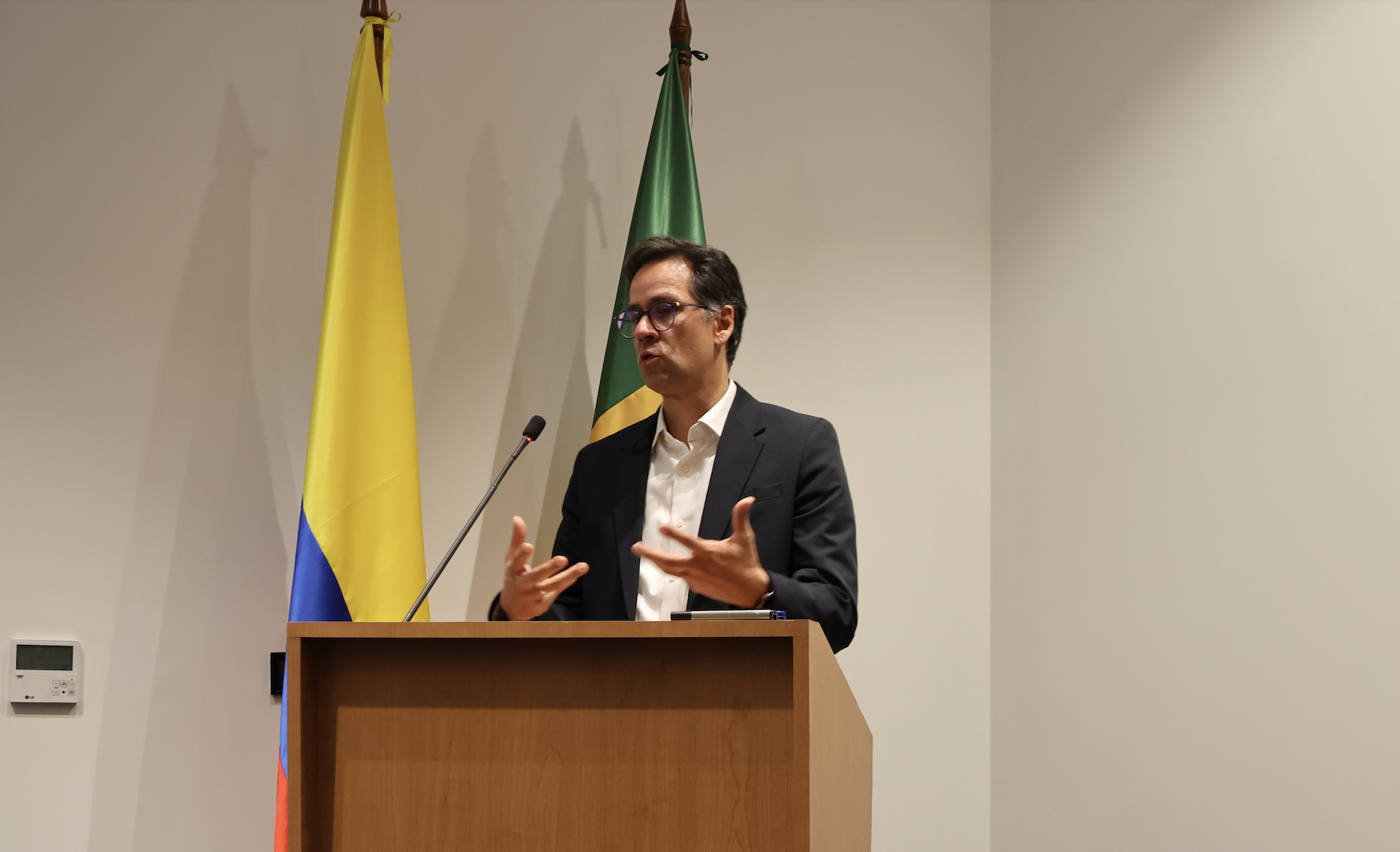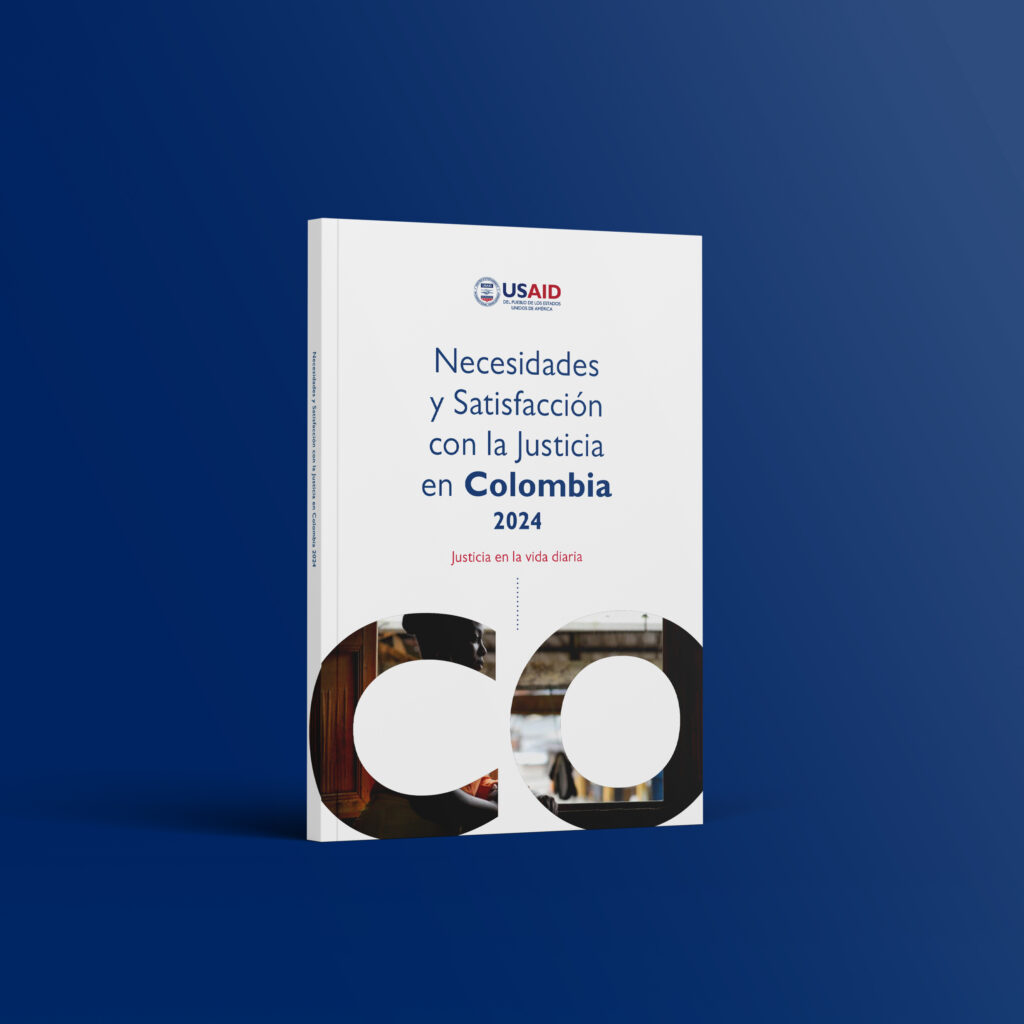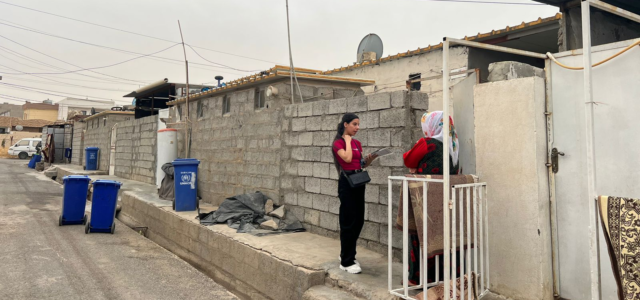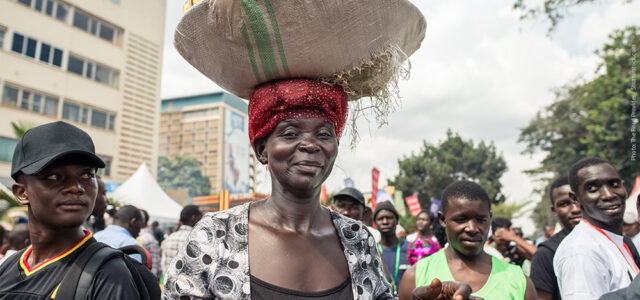
Working from data forms the bedrock of justice system change. Guided by insights into the needs and realities of individuals, we recently released the first Justice Needs and Satisfaction (JNS) survey in Colombia, implemented in partnership with the Inclusive Justice programme of USAID.
This study of over 6,000 people provides a clear lens into their legal problems. It also equips justice practitioners with the knowledge needed to enact informed decisions.
We sat down with Alejandro Ruiz-Acevedo, the chief of party of USAID’s Inclusive Justice project in Colombia, to understand how the JNS and the utilisation of data and insights surrounding justice needs can foster positive transformation within communities across Colombia.
Our conversation took place on the same day as the launch of the Justice Needs and Satisfaction report in Bogotá, Colombia.
“Data to action is what we saw today. Data to action is seeing local justice committees taking that data and understanding that they need to do more in terms of, for example, dealing with conflicts between neighbours, and how they need to actually make available alternative dispute resolution mechanisms, for the municipality itself, so that these issues can be addressed as soon as possible.”
Watch the full interview:
Q&A
Q: How has data been used in Colombia throughout the years and has it yielded any results in the justice sector?
”Okay. Yes, data has been utilized, as we saw today. Since 2007, roughly, the country has taken a decision to actually gather data on the state of justice in the country.
That has been, for many years, data that comes directly from the main cities. And the main idea is to see how the justice systems, basically the institutions, are operating. If there are enough judges, if there are enough attorneys, if the services, if the number of cases, what is the speed of the cases, their resolution.
And that gathering of data has been started from 2007 up to now, but it has been slowly starting to focus on the user. The first questionnaires that started to ask this started a couple of years ago, around 2016-2017, they started to ask people how they perceive justice is operating, mainly in main cities. The surveys that the national planning department has been doing has mainly focused on bigger cities.
And what we have done this time is actually to gather the same type of data with a much more deeper understanding of how people relate to the conflict that they have. As you know, if there is any further consequence on their health, or how much money they have spent on the case, that gives us a little bit of a better understanding of how people at the rural level are dealing with issues. And this complements very well with what the national planning is actually doing.
They have been thinking at the national level, and also how services are being provided at the main cities. But this data actually correlates and gives a better outlook on what is the need in terms of services, and how they can start linking themselves with other operators of justice. For example, community mediators, community conciliators, that actually can deal with issues and with conflicts themselves.
And I think from today, the launching that we did today was very special, because for the first time I heard one of the magistrates that was there at the event and said that he had actually, I mean, that his mind blow of understanding how important it is to start bringing other stakeholders, different than the judges, different than the attorneys, to really think through what are the needs and how justice issues can be solved from a perspective of so many different stakeholders, different than just the high-level entities.
So we’re breaking barriers here, and also I want to mention that in the implementation that USAID has been doing for many years, starting smaller municipalities on setting up their own decision bodies on justice that we call local justice systems and local justice committees, the entities that actually make decisions. They have been making decisions based on qualitative data, basically not quantitative data, qualitative, based on the stories that they know that is happening around their own communities, on the stories of gender-based violence, on the stories, for example, on issues that have been raising from a neighbor’s conflict to a big sort of like homicides itself. But it has been working so far, and the data that we have been utilizing has been different up to this point.
I think this survey and the collection of more data that we’re trying to do from the entities themselves to bring into a bigger consortium of data to really make decisions is actually going to be changing the way that justice local committees are actually making decisions and how we bring data down to the beneficiaries and to the stakeholders that actually deal with the issues so that they can actually push further their own agendas at the municipal level. So I think this was a very important event here in Colombia.
Everyone, as you saw, from the magistrates to the Department of National Planning, the Ministry of Justice, and the academia, and also the private sector and civil society students, they do now understand that we are now moving the agenda forward into making sure that decisions are being made based on data, based on analysis, and that justice is an important fundamental structure to build peace in this country.
Q: How did this particular JNS come about? What were the steps that led to the initiation, from thinking: ‘we are going to do a JNS that will look at the 16 municipalities’ to today having the launch and inviting all the different stakeholders?
I mean, this is an idea. I mean, USAID has been working in Colombia for many years, for more than 30 years have been working here. They started to support initially justice houses, then they thought that they move into the oral panel system.
That was basically before the judge was making the decision himself or herself based on data that they were gathering. But then they brought the two parties so that they have equal representation and on an oral basis they can actually represent themselves. A full structure was established, and this is the current structure that works here.
And the US, with US support, this new system was evolved that was the main focus of USAID for many years up to the year 2010. USAID was actually supporting that. But then they shifted from the year 2010-12 onwards on understanding that access to justice was about working with people, working with conciliators, working with mediators, working with the structure at the local level, understanding what is in there.
And there is ongoing practices taking place at the municipalities where the state is not present. They have already established mechanisms of dealing with issues. USAID comes on board, understands this, builds these local justice systems and local justice committees from the year 2012 onwards.
However, that setting up, making everyone, all the stakeholders to understand why this is important, why decision-making bodies at the local level were critical to build trust, not only from the municipalities, but also trust in the way of how decisions are being made, and also trust in the institutions, because of the war in Colombia, the internal war, different stakeholders have played justice roles in their municipalities. And then from the sound, when they are empowered to have that capability and really build on their own decisions at the local level, they started to bring different ways, as I mentioned before, on how to bring data and what data we have, and the data were mostly oral data, that we know that this happened here, that we know this happened there.
And for this new iteration of USAID, USAID in these 30 years have had different programs on board. For this new program that we started in the year 2022, we came with the idea, we proposed to USAID to gather data at the municipal level, to fulfill the gap that was not there. The decisions were based on oral information, but not on quantitative data.
Therefore, we pushed the idea to USAID to put, along with HiiL, this JNS and the eJNS, the way why we ended up with the 16 municipalities was just more of a methodology arrangement that we did with HiiL. And I think at the end it went really well, because we have representation of smaller, very rural municipalities to municipalities that are of a medium scale, they’re not that big, but we have a very good representative sample that actually talks about how, because this sample is replicated in the entire country, mostly about the same. So we can actually make an estimation of how these municipalities are, but we’re going to be correlating that data that we gathered with the JNS with the eJNS, because the eJNS is now specific on municipality-wise.
So we expect with this first iteration that HiiL will help us to do that. We will see how we can actually deal in the future with new iterations and new ways, and also with DNP and other stakeholders that really want to continue supporting this, so that we can gather that data, bring that data down to those municipalities and start really pushing the idea that decision-making processes should be based on data to fulfill the people-centered justice premise of having decisions based on evidence.
Q: Would you say that it has always been important, the use of data in the justice sector in Colombia, or is it something that is becoming important now with this new data that has been released?
I think, as I mentioned before, we started to collect data as a country since the year 2007 onwards. And from that time onwards, the different stakeholders that work in justice, in the justice sector, started to understand why this is important. And why this is important also to have a mechanism of ensuring that the system is working well.
Because before they were just working by themselves and nobody was noticing that. Now, on this area of communications and data, everyone is really ensuring that accountability happens in all the different sectors, including the justice sector. So with this new launching, and with this event that we have, the data shouldn’t be stating at the national level that we need to make sure that it actually goes into the municipality and to the people who are actually dealing with it.
I think this is going to be triggering a lot of different changes. At the national level, definitely. We saw the magistrate, the magistrate from the Judicial Council, she said that they’re going to be building a greater database that is going to conglomerate all this information.
Because they are now aware that they cannot actually fulfill the need of justice in the country, but just by looking at the number of judges and where they’re located, but they need to look into a larger perspective about what are the needs of justice and how they can center those needs and actually bring the appropriate solution based also on the context of each one of the different places that they have. They’re just having the same approach everywhere.
It doesn’t work, so they will need to change and trigger different policies and approaches to do that better.
Q: Is there a need right now to integrate data in the work of the public sector, in your opinion?
I think there is, I mean, in Colombia there is a lot of data being collected by the prosecutor’s office, by the judges, by the Minister of Finance, by the private sector. I think it’s not, I think data is already there, but it’s how we collect that and how we present that. So I think the upcoming challenges are going to be how we are going to be starting integrating this data, how we understand the differences of ethnicities, of particular characteristics of an ethnic population with the differences also that LGBTIQ plus people have, and women have, and youth, etc.
So that the policies at the local level can actually be raised, the right policies and approaches to deal with those issues at the local level. I think that’s very important and I think also that data is going to start, has changed somehow the way that the justice sector has improved, but I think this new approach is going to be furthering, increasing the amount of surveillance from the civil society on what is going on in justice, but also people will know and will start demanding more services and better services from the justice sector.
Q: What is your vision for the future of working with data in Colombia?
I think in Colombia there’s a lot of opportunities and there’s lots of different stakeholders willing to support this. I think the private sector is doing something very interesting because of their interest to make sure that they have data that they place in the private sector. They are willing to support this type of initiative.
We also understood that having data helps people to make proper and good decisions. Santander de Quilichao, one municipality that we support, the secretary of state was there, the part of the municipality was there, and he mentioned that they’re doing day-to-day. So definitely data is going to be critical, for sure, but the decentralization of decision-making at the municipal level has been one, has been triggering that need for the entities themselves to gather that information.
So it’s not decentralizing funding, it’s just decentralizing the decision that they made at this local justice system and local justice committee to bring all the key critical stakeholders so that they can improve the way access to justice is taking place. And data is enhancing that capability, definitely.
Q: And for this JNS in particular, do you expect that there will be a second fold? Sometimes we’ve done that at Hill where we had a first JNS, then a second wave, a third wave, sometimes asking exactly the same people. Is that something that you could envision for this type of work?
I would love to have a second and a third. I think it would be good to have or continue that conversation with national entities. I think, as we did today, we have passed this process.
As you know, the international cooperation stands for a short period of time. We don’t know what is going to happen with the Colombia-US relationship and if they will continue funding this type of programs in the future. And I certainly advocate for Hill to continue having these conversations with the national government, with academia, with all the critical stakeholders that we have already discussed.
Because I think a second iteration, a third iteration, etc. onwards, I think will make a lot of sense. The government definitely is planning to have one soon.
As a program, the inclusive justice program of USAID, we don’t plan to do that anymore. We’re planning now to see how we can utilize that data, but I think it will be important for Hill to continue this conversation and see if we can continue improving the way the data is being collected and how that data can continue fueling all these different communities that are actually making decisions at the local level.
Q: The theme of HiiL’s next newsletter is ‘From Data to Action’. Is there is one thing that comes to mind when you hear ‘data to action’, especially in the context of this JNS done in Colombia?
Data to action is what we saw today. Data to action is seeing local justice committees taking that data and understanding that they need to do more in terms of, for example, in neighborhoods, conflicts, and how they need to actually find mechanisms, alternative dispute resolution mechanisms, to be available to the municipality itself, so that these issues can be addressed as soon as possible. And we have already, through the project, have been implementing an alternative dispute resolution toolkit to be given to lots of different stakeholders that actually deal with this type of issue.
yeah, I think the action to data is that. It’s actually bringing that data. I think this neighborhood, these neighbor conflicts that was raised in the report actually bring a very clear headlight that many municipalities will immediately start reacting to that.
So, I think it’s just finding the mechanisms, the ways, and the places where the decision can be made. Otherwise, I mean, we end up having another beautiful report that is going to be in a beautiful shelf in somewhere in this world and nothing will happen. I think it’s just how you bring that data and give to the critical stakeholders, the decision makers at the right place and they can start triggering immediate actions.

Highlights from the JNS report
The results of the survey provide a clear picture regarding the landscape of legal problems in the selected municipalities.
- Access to justice is a broad societal problem—55% of the population experienced at least one legal issue in the past four years, with only 47% of those having been resolved.
- The most common problems are related to neighbour disputes, crime, access to public services, and land issues.
- 58% of people take action to solve their legal problem. 43% of them try to do it by talking directly with the other party.
- Although less than half of the problems are resolved, most people who achieve a resolution (60%) consider it fair.




